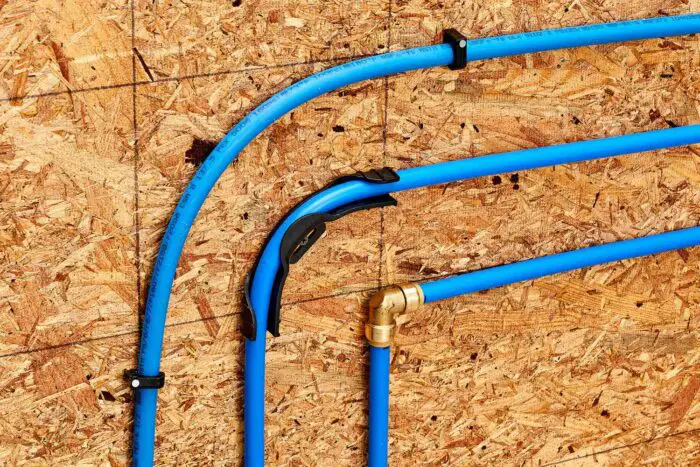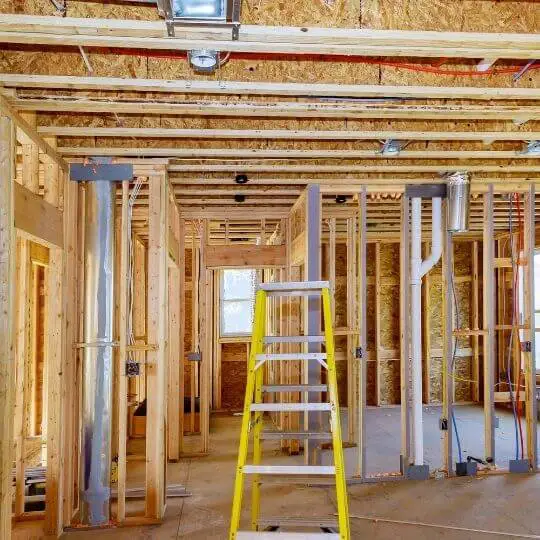Is replacing galvanized pipes with PEX a good idea? Well, let’s explain.
Homes constructed before the 1960s often had galvanized steel pipes installed. These sturdy pipes have a layer of zinc inside that strengthen and make them durable. Over time, however, the zinc layer within the pipe rusts. The corrosion will result in rust accumulation, leakage and restriction of water flow through the pipe system.
Galvanized pipes have a lifespan of about 50 years. So if your home still has its original galvanized pipes, they most certainly aren’t working as effectively as they should.
PEX vs Galvanized Pipe

On the other hand, PEX pipes are constructed from flexible plastic. PEX pipes are made of molecules that are joined together in a bridge-like structure for optimal security and performance.
It undergoes processing to make the polyethylene material resistant to chemicals, corrosion, extreme hot or cold temperatures, and deformation due to prolonged exposure to stress.
Many people believe that PEX piping is one of the most important developments in modern home plumbing. It was created in the 1960s and has effectively served as the American industry standard for durable and effective piping since the 1980s.
PEX can survive extreme heat and cold, but they are not robust enough to be utilized outside the house. The fact that PEX pipes cannot be recycled and be directly linked to a water heater are further drawbacks of PEX pipes.
However, compared to other modern pipe types, PEX is less expensive, uses fewer fittings, doesn’t require soldering or gluing, and can be used for both hot and cold water.
PEX pipes are thought to last for 50 years or less on average. Nonetheless, some things, such as being exposed to UV radiation, can shorten its longevity. Because of this, it’s advisable to keep the PEX Pipes out of direct sunlight.
Another drawback of galvanized pipes is that calcium from the water tends to accumulate on the inner surface, slowly blocking the pipe until it becomes clogged. However, calcium build-up is not an issue with PEX pipes.
Additionally, galvanic or electrolytic corrosion, which is brought on by differences in linked metals, is another issue with galvanized steel pipes [1].
If a dielectric union isn’t employed, the steel in galvanized pipes will quickly corrode wherever the steel pipe touches copper.
Benefits of PEX Pipes

When you realize it’s time to repipe your home after speaking with a repiping plumber, you should think about PEX plumbing. PEX is flexible cross-linked polyethylene piping that may be put in almost any type of building. Some advantages of this excellent pipework include:
- Installation that is quicker and simpler (which also lowers the project cost)
- Non-corroding substance
- Defense against freezing
- Energy-efficient design (which also saves money on heating costs)
- Extended lifespan
PEX piping may be installed without the need for glue, solvents, or torches, making it simpler to install. It also prevents the release of potentially dangerous chemicals into your water. Overall, PEX can be a more economical piping alternative for your home. It also works well over time, saving you money on heating costs, repiping repair, and other expenses.
Replacing Galvanized Pipes with PEX
There are several indicators that galvanized piping needs to be replaced. Even if a plumbing issue doesn’t look severe right away, it could become disastrous very quickly. The property may sustain significant damage if the pipes rupture or break.
If you own a house that is more than 30 years, you need to be alert for the signals that a repiping plumber should be called. The following are some indications that your galvanized pipes may need to be replaced:
- Inconsistent water pressure
- Discolored water
- Water that tastes or smells bad
- Brown stains on sinks, tubs, and other fixtures
- Persistent water leaks
None of these are absolute signs that your pipes need to be replaced, but they are all reason enough to contact a plumber to learn more. Keeping outdated and damaged pipes in place simply increases the potential for property damage and health risks for your family.
How to Replace Galvanized Pipes

The process of replacing a water supply system is known as repiping. The old, easily accessible pipe is often removed during this process, and the new plumbing is then installed.
New PEX water supply pipes are set up as part of the procedure. The water is switched back on when the new plumbing system is installed, and the plumbing is pressure tested before being flushed.
The installation of the new piping system takes approximately 1-3 days. Wall repair will be necessary following the plumbing replacement. [2]
Follow the steps below to replace the galvanized pipes by yourself.
- Cut off your home’s water supply. You can either do this at your main water valve, which is located where the supply line enters your home, or close to the street where your meter is.
- Drain all of the plumbing systems or, at the very least, the area where the pipe needs to be replaced. Run every faucet, shower, etc. until there is no longer any water flowing out. This is done to remove any water that had accumulated in your pipes.
- Remove all of the outdated galvanized pipes. A hacksaw, band saw, or suitable metal tube cutter can be used to cut through galvanized pipes. Remember that water may still be in the pipes, so be prepared with a bucket or canister to catch any spills.
- Use a threaded transition fitting to switch from a galvanized pipe or fitting to PEX tubing. A dielectric union can be required, depending on the kind of PEX fittings that are utilized.
- Use appropriate tools and techniques to join the PEX tubing to the fitting.
- Verify the correctness of the connection. To ensure a leak-free installation, pressure test the system.
Call in a plumber to help
A successful repiping operation depends on a thorough site investigation. The installation of brand-new hot and cold domestic water pipes is a standard component of repiping projects.
It is therefore advisable to contact a local repipe business that specializes in upgrading indoor plumbing to replace your galvanized pipes. A reliable plumbing expert should supervise the installation of the pipes because of several variables that are unique to your house, and the plumbing itself.
There are many reasons to repipe using PEX Plumbing, and for results that last, it’s crucial to work with an expert team. For instance, all of your warranties may be worthless if the system is installed in your home by a person who is not authorized by the PEX manufacturer.
Cost of replacing galvanized pipes with PEX
The costs associated with the replacement of galvanized pipes with PEX vary depending on the following factors:
- The type of material utilized
- The size of your home
- The number of stories
- The number of bathrooms
- The total number of water fixtures in your house.
Although it is an investment in your property that ranges from moderate to expensive, delaying it may end up costing you more money overall.
When adopting PEX as the replacement for the galvanized pipes throughout the entire house, costs can range from around $4000 to $15,000. PEX is less expensive than alternative materials like copper or brass since it involves less home demolition.
Related: PEX A vs PEX B
Conclusion
Galvanized pipes start to corrode from the inside out, leading to pinhole leaks, rust-colored water, and changes in water pressure and temperature. Galvanized pipes have the drawback that occasionally you don’t notice an issue until it becomes significant.
It is normally advised that you get a total house repipe to replace all of the galvanized plumbing once you start having issues with your 40+-year-old galvanized pipes.
This procedure will safeguard your house from harm and improve your living conditions, including clean water, good water pressure, and consistent water temperature.
It’s crucial to speak with a repipe specialist or expert if you’re thinking about replacing galvanized pipes with PEX pipes. The plumber will use assessment and leak detection equipment to identify the location and cause of your pipes’ faults.
They will then use the appropriate technology and tool to replace the old galvanized pipes to guarantee optimal operation.

Michael Davis is a heating & plumbing expert who currently works as independent contractor in SC. He also writes for Plumbertip.
For almost 10 years he worked on various plumbing tasks across South Carolina.



